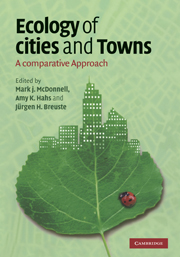Book contents
- Frontmatter
- Contents
- List of contributors
- Preface
- 1 Introduction: Scope of the book and need for developing a comparative approach to the ecological study of cities and towns
- Part I Opportunities and challenges of conducting comparative studies
- Part II Ecological studies of cities and towns
- Part III Integrating science with management and planning
- 21 Structural analysis of urban landscapes for landscape management in German cities
- 22 Preservation of original natural vegetation in urban areas: an overview
- 23 Homogeneity of urban biotopes and similarity of landscape design language in former colonial cities
- 24 Tools to assess human impact on biotope resilience and biodiversity in urban planning: examples from Stockholm, Sweden
- 25 Landscape ecological analysis and assessment in an urbanising environment
- 26 Applying landscape ecological principles to a fascinating landscape: the city
- 27 A trans-disciplinary research approach providing a platform for improved urban design, quality of life and biodiverse urban ecosystems
- 28 Pattern: process metaphors for metropolitan landscapes
- 29 Valuing urban wetlands: modification, preservation and restoration
- Part IV Comments and synthesis
- References
- Index
- Plate section
22 - Preservation of original natural vegetation in urban areas: an overview
Published online by Cambridge University Press: 04 March 2010
- Frontmatter
- Contents
- List of contributors
- Preface
- 1 Introduction: Scope of the book and need for developing a comparative approach to the ecological study of cities and towns
- Part I Opportunities and challenges of conducting comparative studies
- Part II Ecological studies of cities and towns
- Part III Integrating science with management and planning
- 21 Structural analysis of urban landscapes for landscape management in German cities
- 22 Preservation of original natural vegetation in urban areas: an overview
- 23 Homogeneity of urban biotopes and similarity of landscape design language in former colonial cities
- 24 Tools to assess human impact on biotope resilience and biodiversity in urban planning: examples from Stockholm, Sweden
- 25 Landscape ecological analysis and assessment in an urbanising environment
- 26 Applying landscape ecological principles to a fascinating landscape: the city
- 27 A trans-disciplinary research approach providing a platform for improved urban design, quality of life and biodiverse urban ecosystems
- 28 Pattern: process metaphors for metropolitan landscapes
- 29 Valuing urban wetlands: modification, preservation and restoration
- Part IV Comments and synthesis
- References
- Index
- Plate section
Summary
Preservation of original natural vegetation in urban areas
Over the past decades models for sustainable development of towns and cities have been created and discussed (see Naess,2001; Itoh, 2003). A component of such an ‘ecological approach’ is to preserve patches of the original vegetation as parts of the green structure in areas designated for future development, and to preserve remnant natural vegetation in already built-up areas. There are many examples from around the world where the original natural vegetation within cities has been preserved (e.g. Greller, 1975; Schmid, 1975; Florgård, 1978; Dyring, 1984; Olsen et al., 1987). This concept involves the preservation of the original natural vegetation in areas where buildings, roads and other structures are to be built, and the preservation of remnants of such vegetation in already built-up areas. Typically, the vegetation will be close to houses, roads and other developed areas. The vegetation can be natural or semi-natural which has developed with little or no human intervention over time. It also comprises stable post-agricultural plant communities such as meadows and pastureland. Thus, vegetation types such as natural and semi-natural forests and woodlands, bushland, meadows, pasture land, heaths, mires and wetlands can be preserved in towns and cities.
The concept of preserving a functioning biotope or ecosystem is of crucial importance in preserving the original vegetation. Preserved solitary trees are usually not included in the biotope concept, but can be studied as remnants of the original vegetation (Oguz, 2004).
- Type
- Chapter
- Information
- Ecology of Cities and TownsA Comparative Approach, pp. 380 - 398Publisher: Cambridge University PressPrint publication year: 2009
- 2
- Cited by

